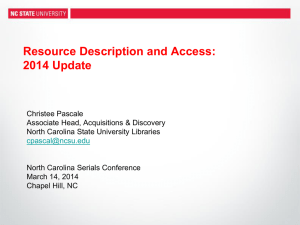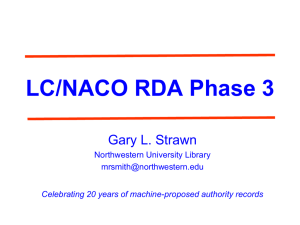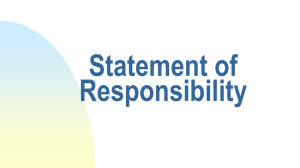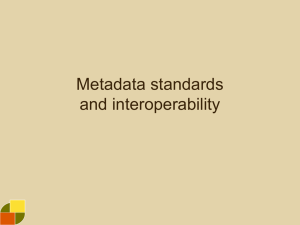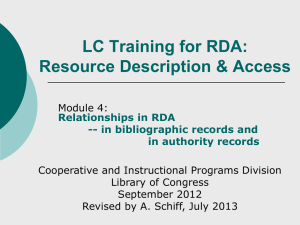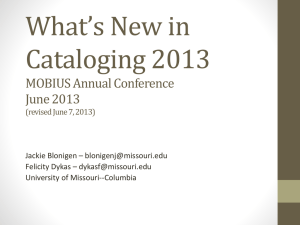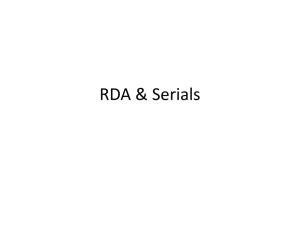Provider-Neutral Records
advertisement
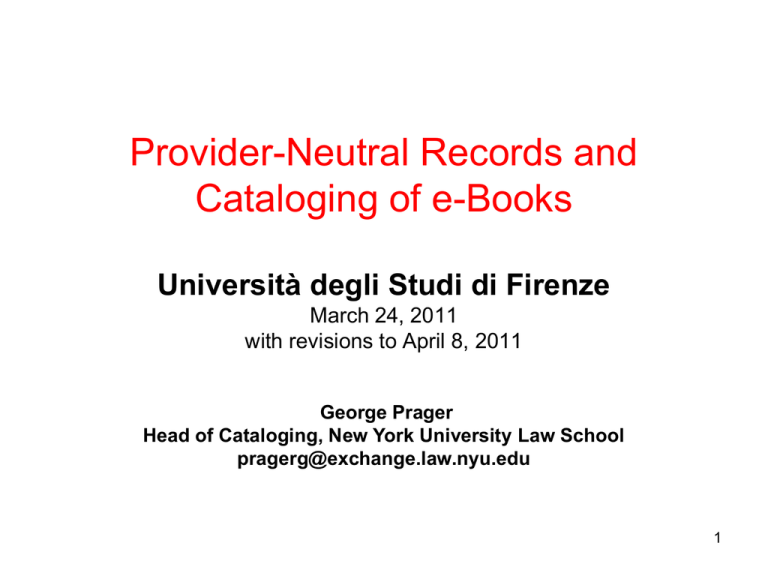
Provider-Neutral Records and Cataloging of e-Books Università degli Studi di Firenze March 24, 2011 with revisions to April 8, 2011 George Prager Head of Cataloging, New York University Law School pragerg@exchange.law.nyu.edu 1 Outline • 1. Provider-Neutral Serial Records • 2. Provider-Neutral Records for Online Integrating Resources • 3. Provider-Neutral E-Monograph Records • 4. Vendor Records and Vendor Guide • 5. Provider-Neutral Records and RDA • 6. Further Resources 2 1. Provider-Neutral Serial Records • Proliferation of remote-access manifestations of serials, essentially identical in content • AACR2 and CONSER* policy called for separate records for each aggregator version – Multiple document formats – Multiple aggregator versions (aggregator is a term for all types of publishers or digitizers of remote-access serials) Examples of serial aggregators: EbscoHost, HeinOnline, ABI/Inform, JSTOR, Project Muse *CONSER is an international cooperative serials cataloging program that is the serials component of the Program for Cooperative Cataloging (PCC), under the aegis of the Library of Congress 3 1. Provider-Neutral Serial Records • Resulting parallel proliferation of serial records for duplicative online versions of same serial – Difficulty and frustration in searching and finding records for e-serials in OCLC, other networks, and OPACs, for copy cataloging and other uses – Increasing amounts of local editing needed for provider-specific records – Difficulty of maintaining records locally and in shared databases 4 1. Provider-Neutral Serial Records • First proposed by CONSER in May 2002 as the “Aggregator-Neutral Record”*: One bibliographic record that represents all essentially identical versions (or iterations) of the same online resource, as long as the content of a particular e-journal does not differ so much that it represents a separate work • No cataloging distinction is made between digital serial reproductions and simultaneous versions (not worth the time/effort required) *In this presentation, I will use the phrase “Provider-Neutral records” or “P-N records” rather than “Aggregator-Neutral records.” 5 1. Provider-Neutral Serial Records • Information specific to one provider should NOT be added to master record in OCLC, such as package name (JSTOR, HeinOnline, most headings with the phrase “Online service”) • Policy applies to all e-journals, but does not apply to titles in article-based databases* • Libraries can still follow the single-record approach for print and online versions *”Article-based databases” are actually integrating resources, not serials 6 1. Provider-Neutral Serial Records • P-N serials policy implemented in July 2003 • OCLC deleted most provider-specific serial records from WorldCat in 2003 • CONSER catalogers and others can report any remaining provider-specific records for deletion • Libraries may do what they wish locally: – Create or add provider-specific or provider-neutral serial records in their OPACs themselves – Use a vendor service like Serials Solutions to add providerneutral serial records to their OPACs* • For an example of how a vendor service can work, see NYU Law School Library’s local record for the Harvard law review (Online): http://julius.law.nyu.edu/search/t?SEARCH=harvard+law+review+%28online%29&sor tdropdown=- 7 1. Provider-Neutral Serial Records • Further information: CONSER Cataloging Manual Module 31, Remote Access Electronic Serials, 2007 draft update available online at: http://www.loc.gov/acq/conser/pdf/Module 31.pdf 8 2. Provider-Neutral Records for Remote-Access Electronic Integrating Resources • Similar problem existed for a relatively small group of eIRs, chiefly searchable, updating bibliographic resources such as subject oriented databases (AGRICOLA, Art Index, Medline, Sociological abstracts, etc.), available from multiple providers • Definition of “Remote-access electronic integrating resource”: a continuing resource (no predetermined conclusion) issued electronically via the Internet that is continued and revised via updates that do not remain discrete and separate, but which are incorporated into the resource” (from p. 2 of PCC report cited in Further Resources) 9 2. Provider-Neutral Records for Remote-Access Electronic Integrating Resources • Final report issued by a PCC task force in October 2007 and policy adopted by PCC shortly thereafter (report available at: http://www.loc.gov/acq/conser/ProvNeutforEIRs-Sept-21-2007.pdf) 10 3. Provider-Neutral E-Monograph Records • Parallel to the increasing proliferation of multiple electronic aggregators for the same serial, many monographs have also become available online through more than one digitizer • Pre-existing LC/OCLC/PCC policy required the creation of a new record each time a new publisher, distributor, or aggregator provided access to the same online resource 11 Provider-Neutral E-Monograph Records • Two approaches were used: – AACR2 1.11A: Bibliographic record describing reproduction, with data relating to the original in the note area (usually MARC 21 field 534). National Archives and Libraries Canada follows this policy* – LCRI 1.11A: Most American libraries followed this policy, describing the original resource in the body of the record, and adding details relating to the reproduction in a MARC field 533** In both of these separate record approaches, a MARC 21 field 776 linking entry was often made to the record for the non-electronic version (usually the print version) *For examples of this approach, search in OCLC for the corporate phrase “Documenting the American South Project” (best to qualify by dates, almost 2000 records) ** For examples of this approach, search OCLC for the almost 2600 records in OCLC for the exact series phrase “LLMC-digital series”, qualified by date) 12 3. Provider-Neutral E-Monograph Records • Multiple providers were offering more and more subjectspecific record sets for e-books, often with considerable overlap among them • Many almost identical records for the same resource were appearing in shared bibliographic utilities and online catalogs • Similar problems as with provider-specific records for the same serial • One example from NYU Law’s catalog: A treatise on American military laws, and the practice of courts martial, by John O’Brien, an 1846 monograph available through at least 3 digitizers, records at: • http://julius.law.nyu.edu/search~S0?/ttreatise+on+american+military+laws%2C+and/ttreatise+on+ american+military+laws+and/1%2C1%2C3%2CB/exact&FF=ttreatise+on+american+military+laws +and+the+practice+of+courts+martial+with+suggestions+for+their+improvement&1%2C3%2C There are nine records in OCLC for essentially identical digitized versions of this 1846 monograph (includes some duplicates from the same digitizer) 13 3. Provider-Neutral E-Monograph Records • Provider-Neutral Task Group formed in summer 2008 by the Program for Cooperative Cataloging • Charged to develop a model for a single bibliographic record to be used for all instances of an online monograph • Policy similar to older PCC Provider-Neutral policies already in effect for serials and integrating resources (databases) • New policy went into effect August 1, 2009 14 3. Provider-Neutral E-Monograph Records • Policy applies to all PCC member libraries coding their records as PCC program records whenever they create or revise master records in OCLC • Guidelines were written for all online monographs, but temporarily being applied only to online books and manuscripts • Guidelines are in the process of being expanded to cover other types of online monographs (eAudio, etc.)* *The changes will be relatively minor. The guide will be revised to sound less “book-centric”, and examples will be added to the 300 field for non-textual online monographs 15 3. Provider-Neutral E-Monograph Records • Recommended, but not required that non-PCC member libraries follow the P-N guidelines for master records in OCLC • Provider-specific records for online monographs created or uploaded to OCLC will however be “neutralized” by OCLC according to P-N guidelines 16 3. Provider-Neutral E-Monograph Records • Policy does not apply to the “Single-record approach” or to local OPACS • Catalogers may: – Add a URL to print record in WorldCat, if one exists – Create an e-book record, if no other record for the same online resource exists – Add URL to print record AND create record for online e-book, if none exists • Reminder: Libraries may do whatever they want in their local OPACS! 17 3. Provider-Neutral E-Monograph Records Provider-Neutral E-Monograph MARC Record Guide (last updated Sept. 15, 2010): http://www.loc.gov/catdir/pcc/bibco/PN-Guide.pdf Includes Metadata application profile, Frequently asked questions, examples of PN records, and a Provider-Neutral Record Comparison Chart General principles from the Guide: • P-N model makes no distinction between records for online versions of monographic titles that are simultaneously issued in print and 18 3. Provider-Neutral E-Monograph Records online, digital reproductions of print resources, and born-digital resources (these distinctions are getting increasingly hard to make) • All online monographic sources cataloged on OCLC should follow the P-N model from Day One, even if the resource is available from only one provider at the time of cataloging • P-N record emphasizes recording only information applicable to all manifestations with the same content 19 3. Provider-Neutral E-Monograph Records • P-N record should not contain information specific to any one particular provider* • Provider or package names are not given in notes or as added entries, or added to uniform titles as qualifiers • Notes about access restrictions, file formats, or system requirements specific to particular providers are also not used on the master record • Basis of description: – If the resource exists only in an online version, the description should be based upon the resource itself, preferably on formally presented evidence. If the necessary information is not available from the resource itself, then follow the order of sources for that situation given in AACR 9.0B. • *with the exception of citing the package and format upon which the record has been based in the “Source of title” note 20 Provider-Neutral E-Monograph Records • Basis of description (cont.): – If the resource also exists in print, microform, etc., then the description may be based either upon the online version, or upon the print or other related version record. Increasingly, record sets are being created for online reproductions of print (microform, etc. versions), through use of macros or other automated techniques, without actual examination of the online resource by a cataloger. The appropriate 5XX notes to use in either case are discussed on slides 29 and 31-33. 3. Provider-Neutral E-Monograph Records Highlights from the P-N Metadata Application Profile (following MARC 21 order): • Fixed-length data elements—additional material characteristics (006) – Only the first byte is mandatory for OCLC records. Use 006/00 “Form of material” code “m” (Computer file/electronic resource) • Physical description fixed field (007) – First two bytes are mandatory, use 007/00 “c” (Electronic resource) and 007/01 “r” (Remote) 22 3. Provider-Neutral E-Monograph Records • 008 Fixed-length data elements—general information • Code as for any online monograph – 008/23 Form of item. Use code “o” • *The P-N Task Force realized early that MARC 21 didn’t clearly distinguish online from direct access resources. Our group submitted a MARBI discussion paper and proposal to add the values “q” for “direct electronic” (such as CD-ROMs), and “o” for “online” to 008/23 “Form of item”, and to make obsolete the older value “s”, “electronic”. See Discussion paper 2009-DP04 and Proposal 201001, available from the MARC Development Web site at http://www.loc.gov/marc/development.html 23 3. Provider-Neutral E-Monograph Records • More on 008/23 Form of item: – New codes “o” and “q” relate to the format of the resource as issued, not to how the resource may be adopted at the local, regional, or consortial level – Codes apply to main resource described – Codes do not apply to accompanying material – Codes do not apply to single-record approach* *That is, a record for the direct access print, microform, etc., version of the resource with an 856 link to the online version should NOT use code 008/23 “o” 24 3. Provider-Neutral E-Monograph Records – PCC implemented new codes on June 1, 2010 – Pre-existing broader code “s”, “electronic”, still valid on records not coded as “pcc”, and may be used locally as well – However, OCLC is converting code “s” to “o” or “q” on a retrospective and continuing basis – New code “o” complements 007/00-01 coded information as well as textual information in 300 $a “1 online resource”, in better marking records for online resources 25 3. Provider-Neutral E-Monograph Records • LC control number (010) – Do not include print LCCN here, but move it to 776 $w instead • ISBN (020) – – – – Record each e-ISBN in a separate 020 $a Record other ISBNs in 020 $z Copy the print ISBN, if any, to 776 $z If unclear which format the ISBN represents, use $z • Classification numbers (050/060/082/086) – Use of major classification strongly encouraged but not required 26 3. Provider-Neutral E-Monograph records General Material Designation (245 $h): Add: “electronic resource” Variant titles (246): retain from source record and add provider-specific title variants if important (but don’t specify) name of provider, i.e.: 246 1# $a Available from some providers with title: $a <title> or simply: 246 1# $a <title> Edition statement (250): record only edition statements originating from the original publisher/society; ignore statements that pertain to specific provider versions Imprint statement (260): record first named publication information that applies to all known instances of the online resource (not the name of a commercial digitizer) 27 3. Provider-Neutral E-Monograph MARC Record Guide • Physical description (300) Use “1 online resource” in $a. If available, include pagination in parentheses followed by illustrative matter, e.g.; $a 1 online resource (25 p.) : $b col. ill.* – If copy cataloging, or deriving the record for the online version from a print, microform, etc., record, the pagination may be taken from the related record. (See “Basis of description” on slides 2021). – Exclude any original statement of dimensions from $c *When the P-N provider-neutral standards are adopted for non-textual online monographs, the statement of the extent in 300 $a will be appropriate for the content: for an online resource of 6 maps: 1 online resource (6 maps) 28 3. Provider-Neutral E-Monograph Records • Series statement (490). Record as it applies to all known instances of the online resource. – Record e-ISSN if any (Remember, 440 field is obsolete) • Source of title (500). Use as first note, but do not use if “Description based on/print other format version record” (DBO) note is present • Restrictions on access (506). Use only for DLF Registry of Digital Masters and similar projects • Additional physical format (530). Generally prefer use of $i in the 776 field 29 3. Provider-Neutral E-Monograph Records • Electronic reproduction (533) – Use only for records for DLF Registry of Digital Masters and other digital preservation projects. Use with $5, giving the MARC 21 code for the institution adding the information • System details and Mode of access notes (538) – Use System details note only for DLF Registry and similar records with $5 – Make a Mode of access note only if resource is accessed by means other than the WWW • Action note (583). Use only for DLF and similar records, with $5* *This note usually relates to preservation actions: 583 1# $a will microfilm $c 2012 $2 pda $5 NNU-L 30 3. Provider-Neutral E-Monograph Records • Source of description note (588)* – Contains administrative information about the record, such as Source of description, Latest issue consulted (for serials), or other non-public cataloger’s notes 588 ## $a Description based on print version record. 588 ## $a Description based on microfilm version record. *One of the newer MARC fields. See MARC Proposal 2009-07 and earlier Discussion paper 2009-DP02 for background. 31 3. Provider-Neutral E-Monograph Records – Also use field 588 for notes combining Source of description with Source of title: 588 ## $a Description based on: Vol. 2; title from PDF caption (publisher’s Web site, viewed July 4, 2010). But: LC/PCC will continue to use 500 field for simple Source of title notes: 500 ## $a Title from PDF t.p. (publisher’s Web site, viewed July 4, 2010). 32 3. Provider-Neutral E-Monograph Records – PCC implemented 588 field on June 1, 2010 – OCLC database project to convert appropriate 500 fields to 588 fields – Further information on 588 field on CONSER homepage: • 588 Draft instructions and examples • Webinar recording • PowerPoint presentation http://www.loc.gov/acq/conser/ 33 3. Provider-Neutral E-Monograph Records • Added entry (700/710/711/730) – Use if applicable to all known instances of the online resource. Do not use for package/provider names (DLF records excepted) • Other format (776) Often used in conjunction with a 588 note. Use 776 $i rather than 530 to describe type of resource recorded in 776 field 776 08 $i Print version 34 3. Provider-Neutral E-Monograph Records Series added entry (800/810/811/830) • Use the authorized print form of the heading when providing an access point for a series that exists both print and online • Use the authorized form of the online series, for series that exist only online • Do not add the qualifer (Online) to any series access point* • Do not use for package/provider series (DLF Registry exception with $5) • Use the print ISSN rather than online ISSN for series that exist in print as well as online* • *The purpose of this policy is to collocate series added entries for the same series, regardless of format. For a detailed explanation of the new series policy, see FAQ 8 in the Provider-Neutral EMonograph MARC Record Guide. 35 3. Provider-Neutral E-Monograph Records • Electronic location and access (856) – Use $u for URIs that are general, NOT institution specific – Likewise, do not use $z for information that is institution specific – Use $3 for provider-name, if URI doesn’t clearly indicate the name of the provider – $3 may also be used to indicate which parts of the resource are available digitally, if only part/s of the resource have been digitized 36 3. Provider-Neutral E-Monograph Records • Copy Cataloging and the P-N Record: – Multiple records: select the P-N record, if present – No P-N record exists: use the record that matches best. Do not add a duplicate record! • But; if content of digital manifestation is significantly different (matter of “cataloger’s judgment”, or lack thereof) from resource/s represented on pre-existing records, create a new record 37 3. Provider-Neutral E-Monograph Records Provider-specific e-book records in OCLC: • Duplicate e-book records being merged in OCLC through automation, record set by record set • Records in process of automated merging often have note: “eContent provider-neutral record in process” • Duplicate e-book records also being reported by catalogers to OCLC for manual deletion • Newly created duplicate records will also be deleted by OCLC 38 3. Provider-Neutral E-Monograph Records • Recommendations for Best Use of P-N Records in Libraries: – Not really the focus of the P-N guide – New task force needed to develop some recommended practices, or options – Libraries can use a single P-N record that contains all specific package and other local information on 1 record, or they can use multiple records, each with one specific 39 3. Provider-Neutral E-Monograph Records package URI – If using one P-N record, they may still wish to add provider-specific added entries – Database maintenance: • Library may wish to have their database de-duped, to merge all provider-specific records for the same resources • Need for vendors to follow the P-N model for new record sets, and hopefully offer all of their record sets (new, old, and ongoing), as P-N records • Need for monographic counterpart of Serials Solutions (good business opportunity!) – Reminder: Libraries still need to follow P-N guidelines when coding master records in OCLC as PCC Program records 40 3. Provider-Neutral E-Monograph Records • P-N Sample Records: Ten sample P-N records were added to OCLC, and are updated as needed. Access records by searching: ut: Provider neutral task force (PCC) example records* *Currently, only 7 records are retrieved via that search 41 4. Vendor Records and Record Guide • Guide for vendors creating e-book records: MARC Record Guide for Monograph Aggregator Vendors first published online in 2006 by PCC • New edition needed because of new P-N emonograph policy instituted in 2009 • 2nd ed. published in October 2009 • Periodically revised, at the same time as the P-N E-Monograph Guide • Available on PCC website under “Vendor Resources” 42 4. Vendor Records and Vendor Guide MARC Record Guide for Monograph Aggregator Vendors, 2nd ed. » » » » » » » » » » » » » » » Table of Contents 1. Introduction ............................................................ 1 1.1 Rationale for Revision .............................................. 1 1.2 Audience ........................................................ 1 1.3 Purpose.......................................................... 1 1.4 Scope ........................................................... 2 2. Record Categories for E-Monographs ....................................... 2 2.1 Born Digital ...................................................... 2 2.2 New Edition of a Print Publication .................................... 3 2.3 Reproduction of an Existing Publication or Manuscript .................... 3 3. How are MARC Records Created? ......................................... 3 3.1 MARC Records Created Directly in MARC 21 Format .................... 3 3.2 Non-MARC Records Created Using Dublin Core ........................ 3 3.3 Non-MARC Records Created Using MODS, XML, HTML, EXCEL, etc. ..... 4 4. MARC Data Specifications ................................................ 4 » » » » 5. Tips for Vendors ....................................................... 17 6. Templates ............................................................. 20 6.1 Template for born-digital record...................................... 20 6.2 Template for electronic reproduction ................................. 21 • • Provider-Neutral Record Metadata Application Profile (MAP) ................. 5 7. Example .............................................................. 23 43 4. Vendor Records and Vendor Guide • Purpose of the guide is “to provide vendors, who do not usually create records in OCLC, with information for producing high quality MARC record sets acceptable to libraries” (p. 1). • Guide endorses creation of records in Dublin Core • Also allows creation of vendor records in MODS, XML, HTML, EXCEL, etc. that will be compatible with MARC 21 • Does not provide guidelines for use of Dublin Core and other non-MARC formats such as the above, but points to relevant documents 44 4. Vendor Records and Vendor Guide • Major part of guide consists of “Metadata Application Profile (MAP)”, on p. 5-16 • Differs from P-N Guide in that it lists ALL fields and subfields that should appear in MARC 21 records; P-N Guide is designed to provide guidance to catalogers already familiar with AACR2 and MARC 21 standards for monographic cataloging • “Tips for Vendors” includes 17 tips, such as where to locate LC classification numbers, how to treat “bound together” titles, etc. 45 4. Vendor Records and Vendor Guide • Guide also includes templates for creating “borndigital” records, and for “electronic reproductions of print or other format version records (Section 6), as well as a record example (Section 7, last section) 46 4. Vendor Records and Vendor Guide • Need to publicize MARC Record Guide and to offer vendors assistance in following guide • Task Group on Vendor-Supplied Bibliographic Records was created in 2006 within the American Association of Law Libraries (AALL) – Works with vendors – Publicizes MARC Record Guide – Offers vendors assistance in following guide and other national standards – Reviews vendor MARC record sets – Offers constructive feedback to vendors on how to improve record quality 47 4. Vendor Records and Vendor Guide – Encourages vendors to make arrangements with authority control vendors, such as MARCIVE and LTI, to supply current authority data for the cataloging produced – Provides helpful documents to library community on adding OCLC numbers to vendor records, quality control through batchload analysis, etc. 48 4. Vendor Records and Vendor Guide – Provides evaluations on record sets to the law library community Task Group Evaluation Format • General information – – – – – – – Name of vendor Contact information Description Records availability Test records availability Methodology for record creation Customization 49 4. Vendor Records and Vendor Guide • Task Group Evaluation Format (cont.): – Evaluation • • • • • • Review status Authority control Fixed fields Variable length fields Subject headings/classification Other – Additional comments This slide and the previous one, courtesy of Alan Keely’s presentation given as part of the Ever-Evolving World of Vendor-Supplied MARC Records (see citation in last section of presentation 50 4. Vendor Records and Vendor Guide • Wiki includes one complete vendor set evaluation • Most recent and future activities of Task Force • What to do with duplicate vendor records already in library databases? • New MarcEdit software update able to de-dupe records even if fields lack unique numerical data* • Information publicly available on Task Group’s wiki (http://tsvbr.pbworks.com) *MarcEdit is a free MARC editing utility developed by Terry Reese; this update was developed by him working with a VBR Task Member, Yael Mandelstam in late 2010. More on MarcEdit: http://people.oregonstate.edu/~reeset/marcedit/html/index.php) 51 5. Provider-Neutral Records and RDA • RDA has replaced GMDs (MARC 21 245 $h) with three new fields: Content (336), Media (337), and Carrier (338)* • Textual online resource: • 245 00 $a Statement of international cataloguing principles • 300 ## $a 1 online resource (15 p.) • 336 ## $a text $2 rdacontent • 337 ## $a computer $2 rdamedia • 338 ## $a online resource $2 rdacarrier *Content and carrier elements are RDA core; Media field is not 52 5. Provider-Neutral Records and RDA • RDA’s treatment of reproductions: • RDA does not seem compatible with the idea of one record for multiple manifestations, which is the basic premise of P-N records • RDA bases the description of reproductions on the reproduction, not the original (RDA 1.11 and specific parts throughout RDA Chapter 2; similar to AACR2 chapter 11 for microform, but a departure from the corresponding LCRI) • RDA requires that the Edition statement and Imprint information be recorded for the online manifestation (the provider), not the original publisher (RDA 2.5.1.3, 2.8.3) • RDA also records information relating to original print, etc. version (if any) in areas of the record relating to the related manifestation (RDA 27.1; MARC 534 and 776 field, or both.). LCPS for 27.1.1.3 gives guidelines for referencing related manifestations, but states that the guidelines do not apply when the single record or provider neutral technique is being used 53 5. Provider-Neutral Records and RDA • LC was applying RDA as written during the test of RDA (no RDA-coded P-N records were created records for serials, integrating resources, or monographs). The full policy is detailed in a document that was posted to the LC website on April 29, 2011: Reconsidering the Cataloging of Reproductions (http://www.loc.gov/acq/conser/reproductions.pdf) • What will be done after the test? • PCC P-N policies have been very successful in “decluttering” national databases and OPACS • P-N serial record policy since mid 2003; CONSER catalogers generally seem very much against returning to provider-specific records 54 5. Provider-Neutral Records and RDA • OCLC also prefers the P-N approach, and has invested much time and energy into eliminating provider-specific records for online resources • Likely that PCC will continue to follow P-N policies • Other approaches: Should MARC holdings records be used for each provider-specific manifestation? (This approach could also be used for microform and other reproductions) 55 5. Provider-Neutral E-Monograph Records Future database scenario: • Create work and expression level bibliographic records, and link records for each providerspecific manifestation to the appropriate expression level record? RDA could work well in this structure – Databases should be able to group related manifestations together, and display them in an user-friendly manner 56 6. Further Resources • Aggregator Neutral Records • http://www.loc.gov/acq/conser/agg-neutral-recs.html • BIBCO Cataloging Standards section of BIBCO Web page, available at: http://www.loc.gov/catdir/pcc/bibco/ • Culbertson, Rebecca. Provider-Neutral Cataloging (Elluminate session, July 23, 2009) http://tpot.ucsd.edu/FrequentlyUsedLinks/PN090711.ppt x • Culbertson, Rebecca. Provider-Neutral E-Monograph MARC Record Guide, 2009- (last updated Sept. 2010) http://www.loc.gov/catdir/pcc/bibco/PN-Guide.pdf 57 6. Further Resources • Dickerson, Gene. Provider-Neutral Records: An Overview, presented at the AALL Annual Conference, July 27, 2009; last revised Aug. 12, 2009) http://www.aallnet.org/sis/obssis/meetings/2009/ Provider-Neutral_Records1.pdf 58 6. Further Resources • Ever-Evolving World of Vendor-Supplied MARC Records: Review of Task Force Work (AALL Annual Meeting, July 12, 2010) http://www.aallnet.org/sis/tssis/annualmeeting/2010/hand outs/vendorsuppliedrecords-handout.pdf • Prager, George. “Treatment of Electronic Monographs”, Technical Services Law Librarian, v. 31, no. 2 Dec. 2005, p. 11-13 • Recommendation for Provider Neutral Record for Cataloging Remote Access Electronic Integrating resources: Report and Recommendations http://www.loc.gov/acq/conser/ProvNeutforE-IRs-Sept21-2007.pdf 59 6. Further Resources • Reconsidering the Cataloging of Reproductions; last updated Apr. 29, 2011; available at: http://www.loc.gov/acq/conser/reproductions.pdf • Task Group on Vendor-Supplied Bibliographic Records Web page (American Assoc. of Law Libraries) http://www.aallnet.org/sis/tssis/committees/catal oging/vendorbibrecords/ 60 • Domande? • Grazie mille! 61
